CQB and the “Floating Angle”
Borderland Nathan
Small mistakes are often the ones that kill, and you are more likely to deal with small mistakes when you treat a dynamic process in a linear fashion. In room entry and clearing techniques we expect to engage a dynamic, oftentimes prepared threat that changes and moves through time and space. More importantly, this threat interacts with us and the environment, and our decisions affect the threat’s decisions and reactions, and vice versa.
We know this, and yet many of our techniques assume an orderly, linear process of clearing that seem to focus more on the room, and less on a capable agent within the room. One subtle aspect of CQB in particular involves what I have come to refer to as the “floating angle,” and this floating angle only comes into play when you give full force to the notion that CQB is a complex adaptive system (CAS) that takes place in real time.
I originally taught this concept in boxing, as an answer to a client that asked me how boxers seemed to be right in front of each other getting punched in the face. To the observer’s eyes, it appeared as though they each saw the punch coming, and yet still got cracked square in the mouth without even attempting to evade. My client was viewing boxing as a linear process, rather than a dynamic process of simultaneously interacting agents.
The answer lies in movement. Boxing is a game of angles, and many of these angles come just as much out of the opponent’s movement as the fighter that is actively striking. I may not have an opening with my jab going straight forward, but if I circle to one direction while jabbing, then reverse direction as he attempts to circle with me, the opponent has a good chance of turning right into a straight shot.
From the bystander’s point of view, both boxers seem to constantly “float” so that they are always directly facing each other. Rarely is a hard angle seen in boxing for more than a split second, instead angles come out of motion that specifically takes the opponent’s movements into account.
This, incidentally, is also why many standard approaches to pad work such as training body shots does not translate well to live sparring. The new boxer has to not re-learn, but rather newly learn an essentially different skill set that involves an adaptive rather than linear system. Stepping at a 45 degree angle to strike the liver on pads is one thing, doing it on a moving opponent is quite another.
In CQB we have floating angles as well, and the one I see most often happens during limited penetration techniques where the shooter is slicing on a door prior to entry. The technique itself is excellent, but approaching it linearly can be lethal.
In Figure 1 below we see a generic approach to slicing, moving from the near to the far side in a semi-circle. The basic idea is to segment the room into manageable chunks during the clear. In this linear model of room clearing, the sections that have already been cleared are implicitly assumed to stay clear. Assertions to the contrary are belied by the fact that after step 3, there is nearly always a “re set” in preparation for the actual entry.
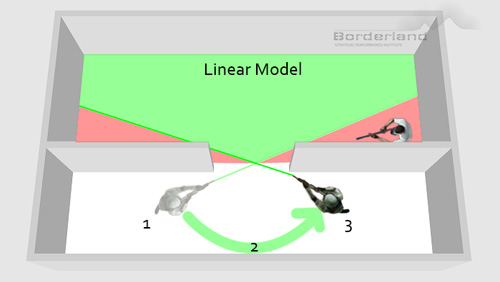
Figure 1
This re-set is necessary regardless of the speed of the technique, since the shooter has to re-center to actually make it through the door. Keep this in mind as we look at the next diagram.
In Figure 2, we use a more dynamic model of understanding, that takes into account agent cognition and interaction between the threat and the shooter in real time. In real life, vision is far more like the cone of a flashlight, and the sector remains clear only as long as the shooter’s attention is focused in that direction. Further, as the room is cleared from one side to the other, it only takes a couple steps for the threat to move with the shooter, so that the threat can end up right in the door threshold as the re-set happens.
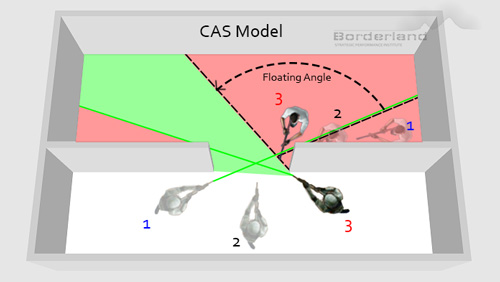
Figure 2
The dotted line sector represents the floating angle, that moves with the clearing visual cone as cleared space becomes unclear space.
An important point is that the floating angle is always created by the clearing shooter. Using a two-man in team movement can help, because the two-man holds that sector as the one-man slices the door, but even in this case floating angles can be created as the one-man moves. This happens in a few scenarios in particular.
1. The threat makes a quick rush.
This can happen laterally across a sector of fire in the case of the two-man, putting the one-man in danger from behind as he slices. It can also happen during the next point
2. During the re-set.
As the shooter prepares to enter, he cedes the ground he has just cleared, at which point the threat can rush out the door and catch the shooter by surprise.
3. Upon entry.
There is without a doubt a psychological aspect to entry that involves cognition, attention, vision, and mental preparation among other factors. Clearing a sector in order to make a decisive entry and psychologically committing to that fact, only to have the threat appear right in your face as you are about to pass the threshold is devastating on an entry. This is even more dangerous during a team clear of an urban structure, in which the domino effect can lead to an entire team being wiped out in a very short space of time.
Floating angles happen all the time in force on force training, and this is particularly so in force on force training where the opposing force is given leeway to actually move and fight back. A very common occurrence is for the threat to manipulate the floating angle to purposefully appear in the blind spot, and counter ambush the entry team. Unarmed threats in particular have reason to manipulate this aspect of room clearing, since it is the only way to really sneak up on and engage the entry team in hand-to-hand.
Potential Solutions
Although a comprehensive discussion about solutions to floating angles is beyond the scope of this article, there are different ways that people have approached the issue. One is a double clear, in which the shooter slices to one side and then back again. This relies on probability and speed, as the shooter is banking on there not being enough time for a potential threat in the remaining uncleared angles to move into a cleared space before the shooter has a chance to enter. Other arguments are that most people in residential homes are near the middle of the room due to furniture, and so there is a low probability that they will be found in the hard slices near the wall.
Still others use more of a corkscrew clear that tightens to the door rather than consistently moving away from the corner, so that sections of the room that have already been cleared always stay within visual sight of the person clearing. This technique is difficult to describe but helps solve many of the above issues.
Of the techniques that do attempt to address this issue, all of them have pros and cons, some more so than others depending on the shooter’s goals. The important thing is to know that superficially, the solution won’t look much different than a technique that appears similar but will get you killed. This is why finding room clearing courses with a knowledgeable instructor that uses current training approaches is so critical. Get away from paper targets in the shoot house, and take it seriously when a couple of your OPFOR wipe out an entire squad. This isn’t a case of “they weren’t acting realistically” to justify a training re-cock, this is a case of inferior entry techniques.
In closing, below is a tragic shooting of a law enforcement officer, in which the threat counter-ambushed by moving with the clearing angle, and into newly-uncleared space. Take this concept seriously.

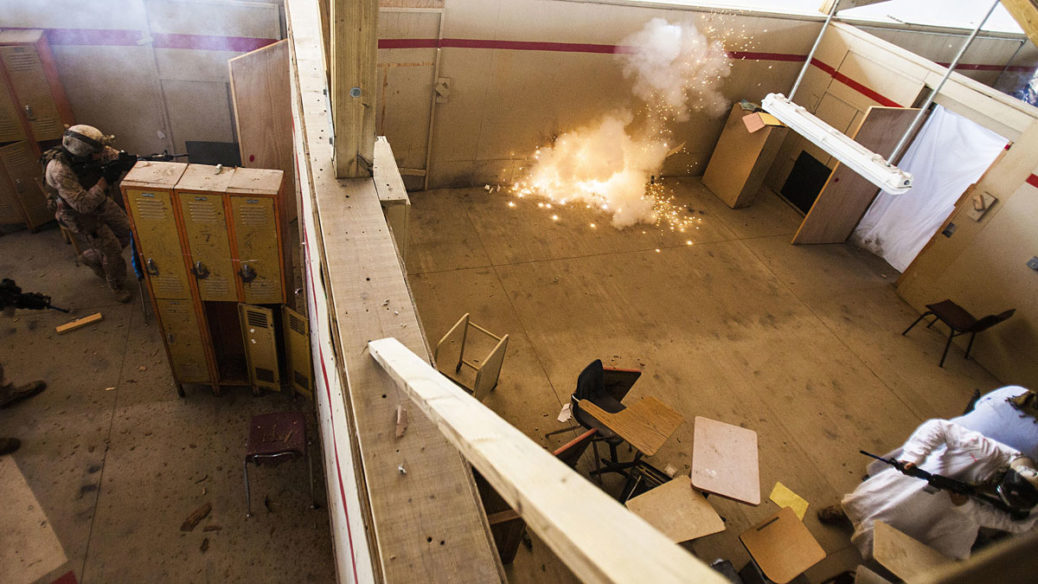
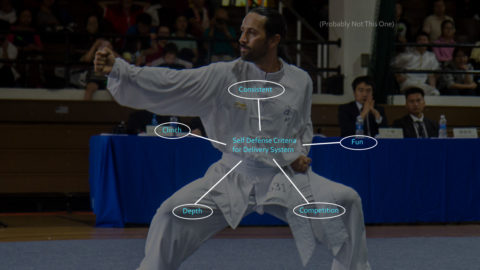
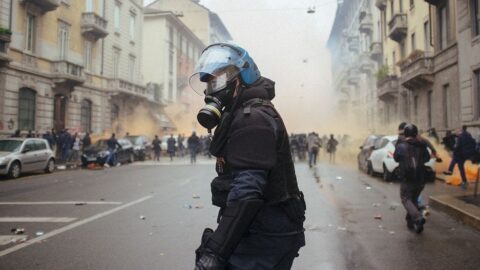

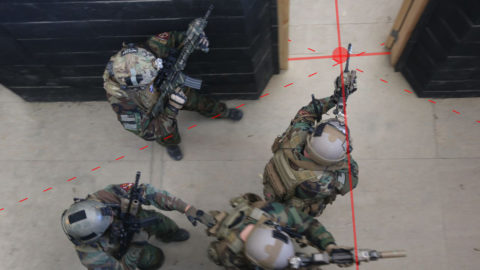


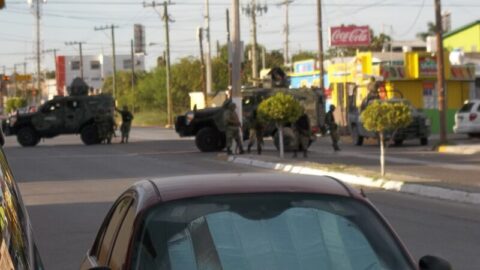

 Rob Brotzman
Rob Brotzman  Nathan Wagar
Nathan Wagar